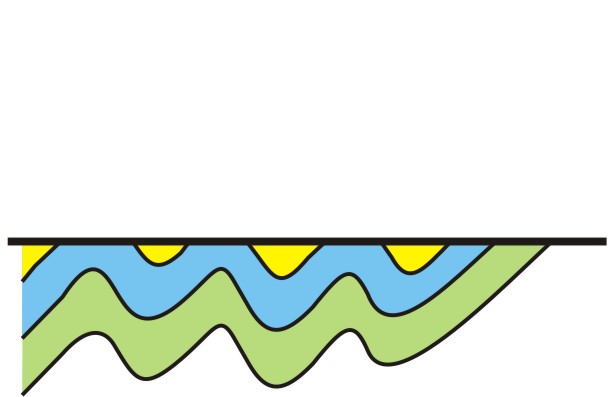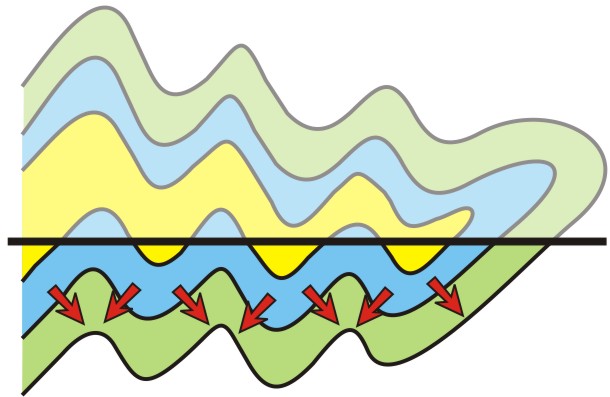4 February 2011
Friday fold: the importance of younging direction
Posted by Callan Bentley
Today’s edition of the Friday fold is a cross-section:

Doesn’t look too spectacular, does it? — “Why, it’s just a bunch of strata folded into anticlines and synclines,” I’ll bet you’re thinking.
But no… it’s actually more complicated than that.
We know it’s more complicated by examining geopetal primary structures in the strata. Geopetal structures are primary structures which look different right-side-up than up-side-down. In sedimentary rocks, this includes things like graded bedding, ball & pillow, footprints, cross bedding, or mudcracks. In volcanic rocks, it might include the position of the entabulature in a basalt flow, or contact metamorphism along the bottom side of the flow, or the accumulation of vesicles towards the top of the flow. Say we find some of these “right-side-up” indicators in our blue layer, and it indicates the blue layer is “younging” towards the bottom. This implies the blue layer is up-side-down:

By paying attention to the “younging direction” of these strata, we have revealed a complication to their story. Rather than being “anticlines and synclines,” these must be antiforms and synforms. Any fold that goes up in the middle is an antiform, but only those with a stratigraphic sequence conforming to superposition (i.e., oldest on bottom & youngest on top) get to bear the name “anticline.” (Ditto for synclines — they’re only synforms until you demonstrate that the youngest is on top.)
If these strata are up-side-down, then they have been overturned. One way to do that is by placing them on the tipped-over limb of a recumbent fold, like so:

The lightly-shaded upper part of the image is our interpretation of what the folded strata would have looked like prior to uplift and erosion, planing them down to the thick horizontal line that represents the trace of the ground surface. Notice that we’ve got two generations of folding here – an earlier isoclinal recumbent fold (very tight — limbs almost parallel, and with a horizontal axial plane) and a second generation which refolds the first (upright, almost symmetrical, vertical axial planes).
I drew these figures in CorelDraw for my Structural Geology class this week. On Wednesday, we talked about primary structures, including the geopetal ones, and I offer this as an example of why it’s important to note all kinds of non-tectonic structures when you’re doing field work — Otherwise, you might miss out on a tectonic structure like the big recumbent fold in this scenario.
Happy Friday to you.


 Callan Bentley is Associate Professor of Geology at Piedmont Virginia Community College in Charlottesville, Virginia. He is a Fellow of the Geological Society of America. For his work on this blog, the National Association of Geoscience Teachers recognized him with the James Shea Award. He has also won the Outstanding Faculty Award from the State Council on Higher Education in Virginia, and the Biggs Award for Excellence in Geoscience Teaching from the Geoscience Education Division of the Geological Society of America. In previous years, Callan served as a contributing editor at EARTH magazine, President of the Geological Society of Washington and President the Geo2YC division of NAGT.
Callan Bentley is Associate Professor of Geology at Piedmont Virginia Community College in Charlottesville, Virginia. He is a Fellow of the Geological Society of America. For his work on this blog, the National Association of Geoscience Teachers recognized him with the James Shea Award. He has also won the Outstanding Faculty Award from the State Council on Higher Education in Virginia, and the Biggs Award for Excellence in Geoscience Teaching from the Geoscience Education Division of the Geological Society of America. In previous years, Callan served as a contributing editor at EARTH magazine, President of the Geological Society of Washington and President the Geo2YC division of NAGT.
[…] This post was mentioned on Twitter by IGEIN, Callan Bentley. Callan Bentley said: Friday fold – the importance of younging direction http://bit.ly/flNcgb […]
Nice illustration. Thanks for the link to Fossen’s structural book, by the way–I purchased it, and it’s very good. The e-modules on the book’s website are very helpful, as well.
[…] Bentley also discusses the importance of younging direction here in one of his “Friday Fold” […]